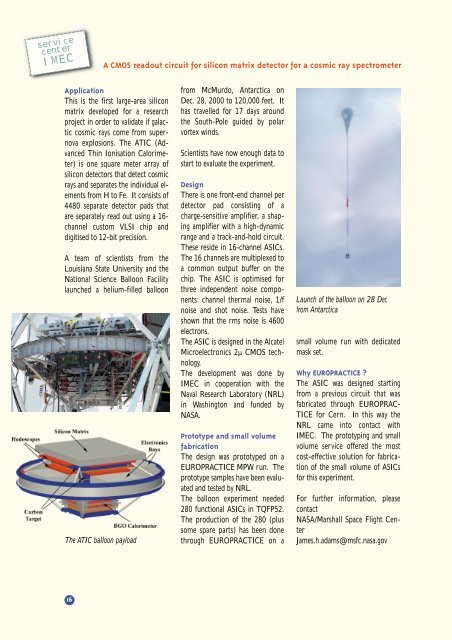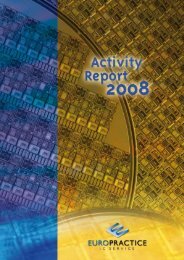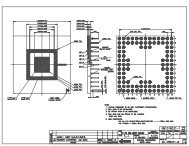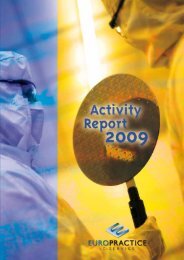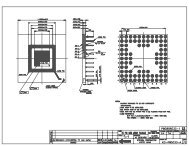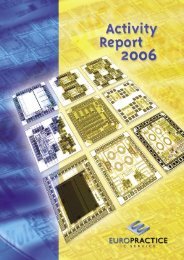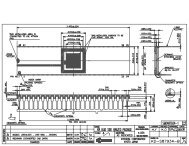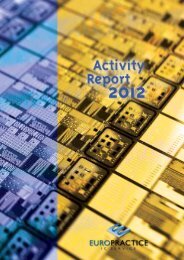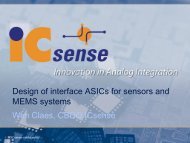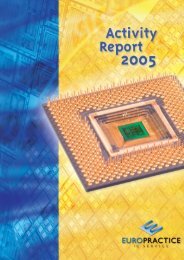Annual report 2000 - Europractice
Annual report 2000 - Europractice
Annual report 2000 - Europractice
You also want an ePaper? Increase the reach of your titles
YUMPU automatically turns print PDFs into web optimized ePapers that Google loves.
---------<br />
---------------<br />
service<br />
center<br />
16<br />
---------<br />
IMEC<br />
---------------<br />
A CMOS readout circuit for silicon matrix detector for a cosmic ray spectrometer<br />
Application<br />
This is the first large-area silicon<br />
matrix developed for a research<br />
project in order to validate if galactic<br />
cosmic rays come from supernova<br />
explosions. The ATIC (Advanced<br />
Thin Ionisation Calorimeter)<br />
is one square meter array of<br />
silicon detectors that detect cosmic<br />
rays and separates the individual elements<br />
from H to Fe. It consists of<br />
4480 separate detector pads that<br />
are separately read out using a 16channel<br />
custom VLSI chip and<br />
digitised to 12-bit precision.<br />
A team of scientists from the<br />
Louisiana State University and the<br />
National Science Balloon Facility<br />
launched a helium-filled balloon<br />
The ATIC balloon payload<br />
from McMurdo, Antarctica on<br />
Dec. 28, <strong>2000</strong> to 120,000 feet. It<br />
has travelled for 17 days around<br />
the South-Pole guided by polar<br />
vortex winds.<br />
Scientists have now enough data to<br />
start to evaluate the experiment.<br />
Design<br />
There is one front-end channel per<br />
detector pad consisting of a<br />
charge-sensitive amplifier, a shaping<br />
amplifier with a high-dynamic<br />
range and a track-and-hold circuit.<br />
These reside in 16-channel ASICs.<br />
The 16 channels are multiplexed to<br />
a common output buffer on the<br />
chip. The ASIC is optimised for<br />
three independent noise components:<br />
channel thermal noise, 1/f<br />
noise and shot noise. Tests have<br />
shown that the rms noise is 4600<br />
electrons.<br />
The ASIC is designed in the Alcatel<br />
Microelectronics 2µ CMOS technology.<br />
The development was done by<br />
IMEC in cooperation with the<br />
Naval Research Laboratory (NRL)<br />
in Washington and funded by<br />
NASA.<br />
Prototype and small volume<br />
fabrication<br />
The design was prototyped on a<br />
EUROPRACTICE MPW run. The<br />
prototype samples have been evaluated<br />
and tested by NRL.<br />
The balloon experiment needed<br />
280 functional ASICs in TQFP52.<br />
The production of the 280 (plus<br />
some spare parts) has been done<br />
through EUROPRACTICE on a<br />
Launch of the balloon on 28 Dec<br />
from Antarctica<br />
small volume run with dedicated<br />
mask set.<br />
Why EUROPRACTICE ?<br />
The ASIC was designed starting<br />
from a previous circuit that was<br />
fabricated through EUROPRAC-<br />
TICE for Cern. In this way the<br />
NRL came into contact with<br />
IMEC. The prototyping and small<br />
volume service offered the most<br />
cost-effective solution for fabrication<br />
of the small volume of ASICs<br />
for this experiment.<br />
For further information, please<br />
contact<br />
NASA/Marshall Space Flight Center<br />
James.h.adams@msfc.nasa.gov


